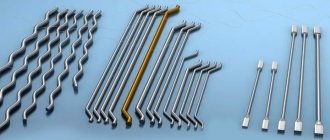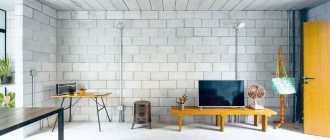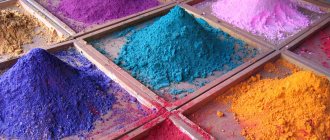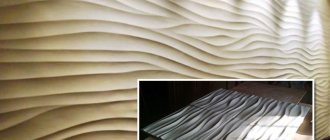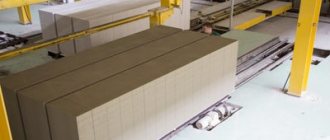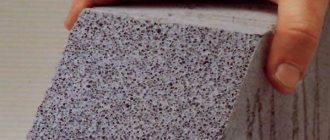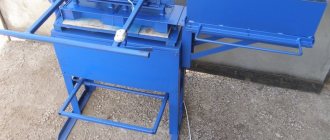Fiber-reinforced concrete is an innovative composite material that is becoming increasingly widespread today. By reinforcing the cement-sand mortar with fiber fiber, the most important operational characteristics of the structural material are significantly improved - durability, strength, bending and tensile resistance, resistance to external influences, etc. The properties of a particular type of fiber-reinforced concrete depend primarily on the type of fiber used.
Short description
Fiber-reinforced concrete is a relatively new building material that has only recently become widespread on the market. However, the first experiments on creating composite solutions using reinforcing fiber were carried out at the beginning of the last century. It is gratifying that the origins of the creation of fiber-reinforced concrete were the Russian scientist V.P. Nekrasov. The first patent for the new material was received by Nekrasov back in 1909.
The main difference between fiber-reinforced concrete and the traditional concrete or reinforced concrete we are used to is the presence of reinforcing fibers in its structure. Small-length and very thin fragments are used as fiber, uniformly filling the internal volume.
The most common fiber is made from steel wire, cut into short pieces a few centimeters long. To increase adhesion, the ends of the segments are bent or flattened. Often steel fiber is given a wavy shape.
Fiber-reinforced concrete with fiberglass reinforcement has also become widespread. This material has many advantages, but there is also a drawback - standard glass has low resistance to the alkaline environment characteristic of Portland cement. Therefore, alkali-resistant glass fibers, such as those based on zirconium, are usually used as fibers.
In addition to metal and glass, fibers from basalt, carbon, cellulose, artificial polymers, etc. are also used to reinforce fiber-reinforced concrete. The distinctive features of these materials will be discussed below.
Let's sum it up
Having studied what fiber-reinforced concrete is, we can conclude that fiber-reinforced composite is a promising building material. It has a set of undeniable advantages and allows you to solve many serious problems in the construction industry. The unique properties of reinforced concrete are appreciated by professional builders and private developers. The characteristics of a composite reinforced with metal wire or synthetic fiber allow it to confidently compete with standard brands of concrete.
Basic properties of fiber-reinforced concrete
The physical characteristics of fiber-reinforced concrete based on different types of reinforcing filler can differ quite significantly. For example, composite materials with steel or basalt fiber are characterized by very good strength and elasticity. But polypropylene fibers have a low elasticity coefficient. Fiber-reinforced concrete based on them are characterized by increased deformability, which means they cannot be used as structural materials.
All this should be taken into account when choosing a brand of material to solve specific construction problems. Let us highlight the main features and advantages of fiber-reinforced concrete in comparison with standard concrete:
• increased durability of structures, extension of effective service life while maintaining all operational characteristics; • high strength and elasticity, resistance to stretching and tearing, ability to maintain integrity under significant tensile loads; • high resistance to atmospheric precipitation and active chemicals; • good frost resistance, the ability to maintain the structure of the material under multiple annual, as well as sharp amplitude temperature fluctuations; • high resistance to temperature increases, intense heating, exposure to open fire, fire safety; • no shrinkage, the ability to maintain the original volume after reaching the design hardness; • high resistance to abrasion, wear, torque, resistance to cracking; • moisture resistance, water resistance; • increased ductility, good impact strength; • good adhesive qualities; • preservation of technical characteristics after the end of the design service life of the material; • reducing the volume of concrete required for construction due to improved properties of the material, reducing the weight of the structure; • high manufacturability of the material and productivity of work on it; • reduction in construction costs by saving materials, eliminating the use of reinforcing meshes and frames, reducing construction time, reducing additional transportation costs, etc.
In terms of strength, fiber-reinforced concrete often even surpasses reinforced concrete, while noticeably gaining in terms of weight of structures. Fiber can also be used to reinforce aerated concrete and foam concrete. Such materials are characterized by low density, high heat and sound insulation properties. And due to fiber reinforcement, they acquire increased strength characteristics.
The only relative disadvantage of fiber-reinforced concrete is its high cost. However, in practice, through the use of this material, it is possible to even increase the profitability of construction.
Composition and proportions of components
This material is subject to all the rules that apply to any wood concrete, therefore the composition and proportions of the components depend on the purpose of the material .
To create a structural material that can be used to create blocks and pour monolithic walls, it is necessary to add an increased amount of cement and sand, resulting in the proportion of wood wool not exceeding 15%.
To obtain a universal material , that is, concrete, which can be used both for the manufacture of blocks and walls, and for the creation of permanent formwork slabs, the proportion of wood wool is increased to 30–40%, and the amount of sand is reduced to a minimum.
If you need
a finishing material that has good strength and good thermal insulation, then sand is removed from the composition, and the amount of wood wool is increased to 50%.
Finishing fiber cement slabs and insulating blocks can be made from such concrete, but it cannot be used for building walls due to its low load-bearing capacity .
If you increase the share of chips to 60–90%, you will get a material with excellent heat and sound insulating properties, but it can only be used as insulation .
Application of fiber-reinforced concrete
The high performance characteristics of fiber-reinforced concrete are due to its widespread use in the construction industry. In particular, it is used for the construction of structures and structures designed for heavy loads and external influences. Fiber-reinforced concrete is also used where high flexibility and ductility of the material, light weight, and good noise and heat insulation are required.
We list only the most typical areas of application of fiber-reinforced concrete:
• foundations, sleepers, bridge coverings, tunnels, floors; • structural frames, floors, monolithic construction; • roads, runways; • hydraulic structures, dams, dams, reservoirs, pools, bank protection strips, drainage shafts, sewer wells; • sidewalks, curbs, paving slabs; • noise protection shields; • finishing of facades, cornices, decorative elements, stucco; • columns, arches, railings, stairs, balustrades; • fences, benches, flower beds; • structures and low-weight objects made of foam blocks and gas blocks.
It is especially worth paying attention to the use of fiber-reinforced concrete in private and low-rise construction, as well as in the finishing and renovation of premises. Here, such material properties as low density, high ductility, and good thermal insulation characteristics often become important.
Thus, reinforced foam concrete can be used for the construction and insulation of walls, and fiberglass-based fiber concrete is optimal for the manufacture of decorative elements. This material produces high-quality figured products, columns, and balusters. Using plastic fiber-reinforced concrete, you can decorate the facades of buildings with stucco molding and floral ornaments.
The high strength of fiber-reinforced concrete, its durability, resistance to loads and external influences makes this material an ideal option for the construction of high-rise buildings, bridges, tunnels, hydraulic structures: dams, dams, reservoirs. In the latter case, such properties of fiber-reinforced concrete as water resistance and high modulus of elasticity are also in demand.
Improvement
The innovative material from the Fibrol factory has also found application in the most high-profile project of 2022 - Zaryadye Park. For the construction of the facades of the “Ice Cave” in the “Reserve Embassy” pavilion, Concern “KROST” used glass fiber reinforced concrete without formwork. The tight deadlines of the project and the bionic shape of the structure itself did not allow the use of traditional panels here and their neat joining. The Concern’s specialists turned to the technology of 3D printing of buildings: they created a three-dimensional model of the facades in a special program, set more than 25 thousand points for installing the subsystem, and sprayed glass fiber-reinforced concrete facades onto it directly on site.
The composite layer was about 30 mm; in total, about 120 tons of glass fiber reinforced concrete were used to produce the facade.
KROST decided to repeat its unique experience in Zaryadye in the Nevsky residential complex, where a similar pavilion is currently being built, developing a marine theme in the improvement project. The process of creating a structure will be somewhat different - if in the park they worked with an already erected pavilion, then in SAO the design department of KROST itself developed the original metal structures of the base for the bionic facades. BIM design, in which the concern's architects and designers were involved, significantly reduced the project development time, and today at the complex's construction site you can see a metal frame manufactured at the concern's plant. The pavilion will have an observation deck with a green slope, a slide will appear nearby, and under the arches there will be a stage for performances.
Category
- Press about the Company
Types of fiber fiber
All types of reinforcing fillers are divided into two groups: metallic and non-metallic. The second includes a wide range of materials: basalt, asbestos, glass, carbon, cellulose, acrylic, nylon, etc. Let us consider the characteristic features of fiber-reinforced concrete with different types of fillers.
Steel fiber
The very first reinforcing fillers for fiber-reinforced concrete were made from steel. This metal is still the main and most common type of fiber fiber today. To make steel fiber, wire is often used, which is cut into short pieces and bent or flattened at the ends (to increase adhesion with the cement-sand mixture). Such fiber is called anchor fiber. There is also a wave (wavy shape) and milled, produced on machines.
Among the advantages of fiber-reinforced concrete with steel reinforcement are the high strength of the material, its durability, increased elasticity, resistance to tension and compression, abrasion, and wear. Therefore, this material is widely used for the construction of structures, high-rise monolithic buildings, hydraulic structures, bridges, tunnels, road surfaces, runways, floors of hangars and industrial premises, etc.
On video: pouring fiber-reinforced concrete floors.
Disadvantages of steel fiber: susceptibility to corrosion, heavy weight, low adhesion to concrete. Such fiber-reinforced concrete is rarely used for facades.
Basalt fiber
Mineral fiber is made from basalt. To obtain it, the volcanic mineral basalt is melted at high temperatures. Basalt fiber is resistant to mechanical loads and the effects of chemically active reagents (including acids and alkalis), and is not subject to combustion. Due to mineral fiber reinforcement, the strength of concrete increases three times.
Basalt fiber reinforced concrete is successfully used for:
• basement and wall panels, interior partitions, monolithic walls, permanent formwork; • small architectural forms, sculptures, fountains; • details of building reconstruction; • finishing of facades, cornices, architectural decor, stucco moldings, balustrades, platbands; • road slabs.
Fiberglass
To obtain fiberglass fiber, different chemical ingredients are used, so the final product can differ quite significantly in its technical parameters. In general, fiberglass-reinforced fiber-reinforced concrete is characterized by high levels of strength, flexibility, ductility, noise insulation, frost resistance, fire resistance, water resistance, etc. The most important advantage in comparison with metal fiber is the low weight of the material.
Main Applications:
• hydrotreatment facilities; • noise protection panels; • coverings of industrial buildings exposed to pollution; • small architectural forms, flower beds, benches, fountains; • reconstruction and restoration of buildings; • finishing of facades, decorative elements, stucco molding.
In the video you can see examples of the use of glass fiber reinforced concrete.
Carbon fiber
Carbon fiber has high performance characteristics. Among the advantages of the material: high elasticity, strength, chemical resistance, non-corrosion, good adhesion, resistance to loads and high temperatures.
The use of carbon fiber-based fiber concrete is limited by the high cost of the material.
Polypropylene
Polypropylene fiber is made from polymer film. The source material is cut into threads 10-25 microns thick. Polypropylene fiber is very lightweight and increases the impact resistance of reinforced concrete. It is characterized by reduced resistance to compression and tension, which increases the deformability of the resulting material.
Polypropylene fiber is widely used in the production of cellular concrete. It is used for the construction of structures made of foam blocks and light weight objects.
Cellulose
Cellulose fiber is made from cellulose obtained from natural materials. Such fibers are characterized by high absorption of water-saturated compounds. Adding cellulose fiber to the solution promotes better and more uniform drying of the screed, reduces shrinkage, eliminates the appearance of cracks, and increases the vapor permeability of polymer coatings.
What it is
Fiber-reinforced concrete is a fine-grained concrete solution that contains reinforcing filler. Previously, due to the brittleness of the material and the presence of cracks, builders tried to increase strength by adding dispersed fibers. The elements were distributed throughout the solution, and as a result, the technical qualities were significantly improved.
In production, 2 types of fiber are used:
- metal - made of steel of various shapes and sizes;
- non-metallic - glass, cotton, polyethylene, acrylic are used as raw materials.
The structure of fiber-reinforced concrete is homogeneous; fibers made of different materials are located on all sides; the characteristics, as well as the effect of reinforcement, will depend on it.
Production of fiber-reinforced concrete
On the market today there are many offers of dry mixtures for producing fiber-reinforced concrete based on various reinforcing materials. In such mixtures, fiber fiber has already been added to the composition in a pre-calculated proportion, ensuring strictly defined physical and technical characteristics of concrete. Builders just have to add the required amount of water to such a mixture, mix and use the resulting solution in the same way as usual.
Another way to produce fiber-reinforced concrete is to add reinforcing fibers yourself. Here, too, there are two options: you can add fiber either to the dry mixture or to the liquid solution, at the stage of mixing it in a concrete mixer. The main difficulty here lies in the need to achieve the most uniform distribution of reinforcing fibers throughout the entire volume of the solution. This usually increases the duration of preparing the solution in a concrete mixer by about 1.5 times.
If you follow the technology, you can independently produce fiber-reinforced concrete of the appropriate quality directly on the construction site. Of course, this is true to a greater extent for private and low-rise construction.
Production technology
The technology for manufacturing fiber-reinforced concrete is similar to that used for the production of wood concrete or any other type of wood concrete. First, wood wool is soaked in an aqueous solution of reagents that break down free sugar and fill the pores. Most often, the following reagents are used :
- slaked lime;
- liquid glass;
- aluminum sulfate;
- calcium chloride.
When the wool is ready, it is mixed with cement and, if necessary, sand, adding the required amount of water. To increase the strength , lime and clay are often added to it .
, air-entraining agents are added to concrete , and superplasticizers .
Thanks to the latter, the amount of water required to give the solution the required mobility is reduced, which has a beneficial effect on strength after hardening.
If necessary, other components are added that change the properties of concrete in the desired direction.
If the production of fiber-reinforced concrete is located far from the place of its use, then
hardening retarders , for which ordinary whey can be used.
However, in order for the hardening retarder to extend the life of concrete for the required period and not harm its strength, a chemical analysis of the cement is first carried out .
frost-resistant additives are added to it , for example, table salt, which reduces the freezing point of water. However, for the correct selection of frost-resistant additives, it is also necessary to accurately determine the composition of the cement.
Features of the choice of materials
When choosing fiber-reinforced concrete (or fiber for its own preparation), it is necessary to clearly determine exactly what requirements are put forward for the material. For example, steel fiber has a maximum elastic modulus and high strength characteristics, but at the same time has a high density and low corrosion resistance. Basalt is characterized by maximum tensile strength and high resistance to chemical compounds.
The greatest problems can arise when choosing fiber from artificial materials. For example, the different brands of fiberglass used can vary greatly in their characteristics. Therefore, you must make sure that the chosen fiber is resistant to alkalis.
In this aspect, the quality of basalt fiber practically does not depend on the manufacturer. But here, too, you need to pay attention to two parameters: the linear dimensions of the fibers and the type of lubricant used to increase adhesion.
An even greater variation in parameters is typical for steel fiber. When choosing it, you should take into account the type of material (wire, wave, milled), its dimensions, and composition. For example, you can use higher quality alloy steel fiber, but this will significantly increase its cost.
